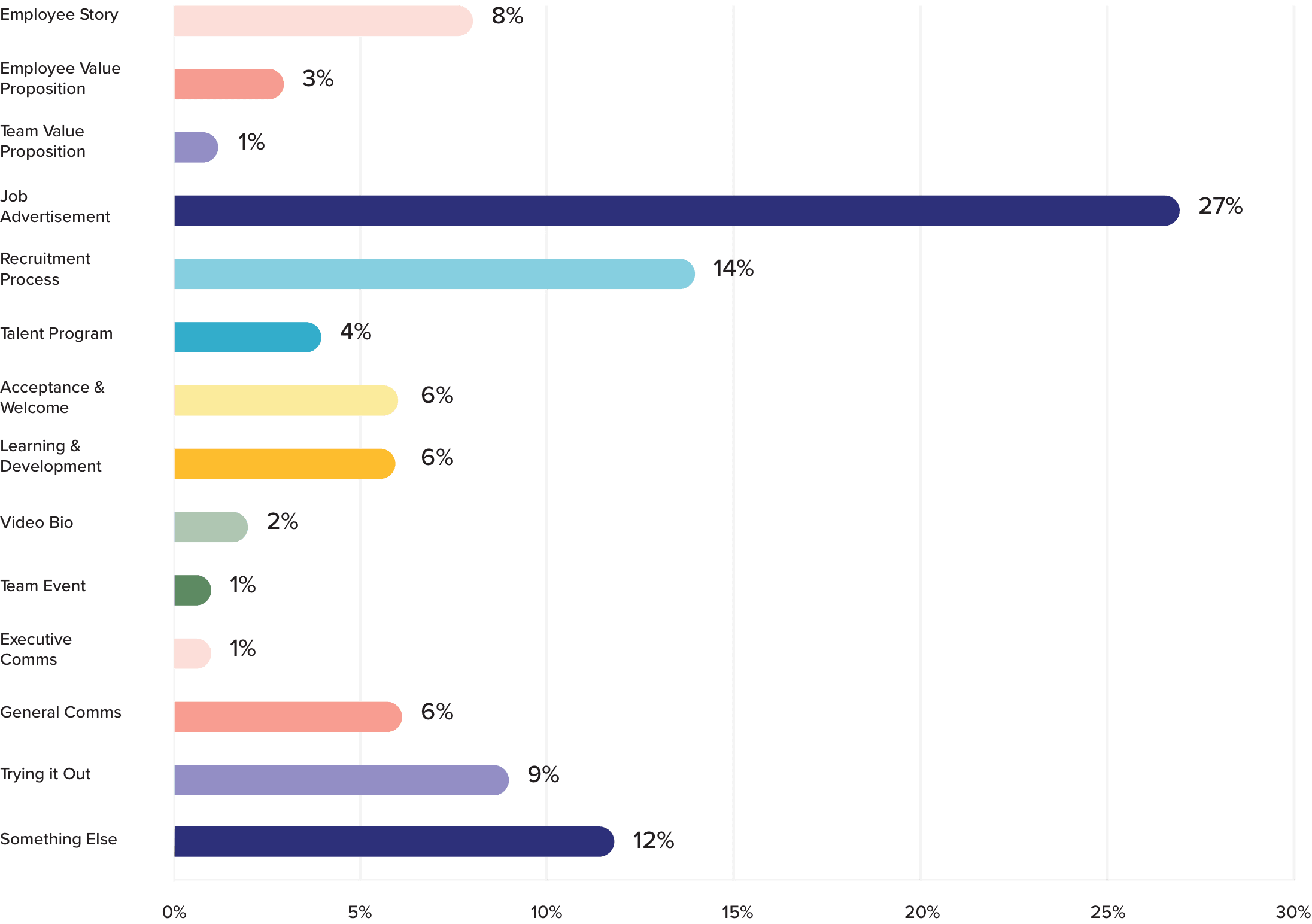State of Video in Talent 2021
The world’s largest research on the use of video to attract, engage and retain top talent.

700+
report responses collected globally
41
countries participated in the report
30%
of respondents are in a team lead/manager role
68%
currently using a video strategy
Overview
A roadmap to help video heroes in the making overcome the global talent shortage.
Download PDFExecutive Summary
How 700 talent experts created the industry’s broadest and deepest research study on video.
Fast Facts
Key results summary on video uptake, popular topics, sharing channels and more.
The Pandemic. Let's Talk.
Let's address the elephant in the virtual room. When a crisis called, video answered.
Why Video, Why Now?
To attract the best talent in a noisy environment and enhance the candidate experience.
Strategy in Action!
Where different sized organizations are successfully putting their investments in video.
Video Maturity Model
Why progression along the maturity curve is dependent on consistency and experience.
A Blueprint for ROI
Creating a meaningful impact and measurable ROI with video is easier than you might think.
The Journey Continues
Why 73% plan to invest the same or more in their video strategy over the next 12 months.
About VideoMyJob
The video creation platform used by video-heroes in the talent industry.
Executive Summary
We're so glad that you have joined us for the second State of Video in Talent (SOVT) report.
This year, we’re thanking more than 700 talent professionals who answered the call for help and made this the industry’s broadest and deepest research study. The result is a deep dive into the latest thinking on how video is being used to attract, engage and retain candidates in 2020-2021.
Now we’ve crunched the numbers, and created a roadmap to help video-heroes in the making, and guide you on the journey to overcome the global talent shortage! This report is your call to adventure. Read it well, and importantly - share it with your fellow talent professionals.
To say a lot has happened since our last report in 2019 is an understatement. We all experienced a decade’s worth of digital evolution in 12 months, as our industries searched for unique and creative ways to enhance business as (un)usual.
In this regard, talent acquisition is no exception. Traditional strategies for candidate attraction and engagement have fallen by the wayside as we navigate the bottleneck of a working-from-home world.
But what this era has clearly defined is the powerful way that video content dominates our social feeds. Video is more engaging, and it builds brand authenticity and tells your story in a way written words cannot.
Our report also reflects the current operating environment for those seeking to attract talent over the next 12 months. Right now, candidates hold the power as businesses in North America, Asia Pacific, Europe and the United Kingdom experience an immense talent shortage and scramble to find suitable staff to fill job vacancies.
Back in 2019, SOVT gauged how talent professionals view the impact of video and the value it adds. This year, we’re looking at video adoption and the different outputs, depending on strategy. We wanted to analyse the evolution of current and future video-heroes and how they developed video as their talent strategy superpower.
The talent community is already adopting many new innovations. While this report’s findings sit within the context of our existing adoption of digital technologies, we have sought to look closely at how talent engagement has evolved, and how this will continue to change in the future as we forge on to a new, hybrid, work-from-anywhere, digital world.
So, put your favorite superhero outfit on and let’s commence our journey shall we?
68% of respondents use video as part of their strategy, compared to 57% in 2019
VideoMyJob, The State of Video Report, 2021

Methodology
The survey was available globally and received 711 responses from 41 countries across a three-month period over April, May and June 2021. We asked both talent professionals and VideoMyJob customers 30 questions about their strategy and adoption of video within the candidate and employee journey to ascertain the blueprint for how to best harness video in the future.
Respondent Profile
Top region represented were: 33% North America, 31% Asia Pacific, 33% U.K/Europe, and 3% Other


Most Common Business Units
- 24% Human Resources
- 21% Talent Acquisition
- 19% Recruitment Marketing
- 9% Learning and Development
- 8% Employer Branding

Current Role
- 30% Team Lead/Manager
- 28% Specialist
- 18% Senior Manager/Head of
- 9% Vice President/Director
- 9% Executive/C-Level
- 6% Founder/Business Owner

Organization Size
- 19% 5000+
- 18% 101-500
- 14% 1001-5000
- 13% 501-1000
- 12% 11-50
- 10% 51-100
- 9% 2-10
- 5% 0-1

Organization Type
- 27% Corporate - Large Enterprise
- 27% Corporate - Small-to-Medium Enterprise
- 9% Small Business or Start-Up
- 9% Government
- 8% Recruitment Agency
- 7% Self-Employed
- 7% Not-for-Profit
- 4% RPO
- 2% Not Working
In the age of IVP, authentic connection and creating moments that matter, video has never been a more critical weapon in your TA arsenal.
Video Maturity Model
For the purposes of this report, we segmented video users into the following video adoption levels:
14% of respondents
Defining how they will use video in the candidate journey and solutions to support it
33% of respondents
Using video for one or two parts of the candidate journey to prove the concept
37% of respondents
Using video for several stages of the candidate journey and measuring results
16% of respondents
Deploying a video-led approach to candidate journey w/ supporting program management
Fast Facts
The State of Video in Talent 2021 key results summary

68%
are currently using a video strategy, with 21% planning to use video

43%
of those not using video, intend to start in the next 12 months

21%
launched and accelerated a video strategy in the last 12 months

Return on (Video) Investment
23% Content engagement (reach, clicks, shares, views, email open rates and click rates)
21% Candidate quality (shortlist acceptance, interview to offer conversion, offer acceptance rate, quality of hire)
19% Cost reduction (cost per hire, cost per applicant, cost by source, cost by lead)

Business Drivers for Video
50% to enhance the candidate experience
50% to better attract top talent or acquire specific skills
40% to communicate their employer brand and employee value proposition (EVP)
40% to improve diversity and inclusion

Most Popular Strategies
45% have added videos to candidate communications for stages in the recruitment process
35% have amplified job ads with videos that feature a recruiter or hiring manager
31% have captured employee stories for employer branding communications

Top Videos Created Globally
42% Employee Stories
39% Video Job Ads
34% Recruitment Process (i.e Interview Support)
31% Employee Value Proposition
29% Day in the Life
25% General Communications

Video Strategy Benefits
92% Employer brand authenticity and awareness
90% Candidate experience and engagement
90% Social media engagement and reach
86% Job ad reach or views
85% Quality of candidates

Video Adoption Challenges
90% Time and effort to create videos
86% Motivating employees to create videos
85% Maintaining consistent video quality
84% How to measure impact and ROI
83% Producing videos with remote teams or workers
Top Sharing Channels
52% YouTube
43% LinkedIn
43% Facebook
35% Company Career Site
32% Instagram
31% Email

Video Production Methods
36% Both smartphone and professional production
35% Smartphone only
29% Professional production only

You'll have better retention and engagement when you give your employees permission to play a starring role by being their authentic selves. Use video to supercharge storytelling. Everyone loves a great story.
The Pandemic. Let's Talk
Before we fly through the rest of the report, let's address the elephant in the room.
The pandemic has led to an increased reliance on technology to communicate. Our means of connection were reduced to two dimensions, but people across the world leveraged innovative and exciting new ways to counteract this and drive engagement.
When a crisis called, video answered.
In a sign of the times, the effects of the pandemic pushed organizations to rely on video more to attract candidates, but also to communicate a vision and keep top talent.


Side Effects
Survey results show there is a clear correlation between the global pandemic and adoption of HR and recruitment technology
65% of respondents confirmed the pandemic accelerated HR and recruitment technology adoption
75% of respondents reported the value of video in recruitment has increased since the pandemic began
Almost one in four respondents reported the use of video to communicate executive and general communications, while, specifically during the pandemic, half of the respondents used video to help leaders communicate with their team during times of uncertainty. A further 46 percent implemented video to keep their dispersed workforce connected.
This increased with organization size: 47 percent of respondents from an organization with 100 - 1,000 employees are using video to help leaders communicate with their teams. This increased to 54 percent for organizations with more than 1,000 employees
47 percent of respondents from organizations with between 100 - 1,000 employees said they used video to help keep a dispersed workforce connected, and four in five respondents from both organization sizes reported using video to onboard new hires remotely.
Video is the best face-to-face solution for staying at home but also keeping in touch with everyone in an emotional and authentic way.
Pandemic Video Use Cases
Ranked list of video use cases during the global pandemic:
#1
To help leaders communicate during times of uncertainty

#2
To keep a dispersed workforce connected

#3
To onboard new hires remotely
#4
To support a return to work / office strategy
#5
To attract critical skills lost after laying off employees
#6
To promote internal mobility within their organization
The shift from using video largely in recruitment to using video in all aspects of engagement has been profound.
Pandemic video strategies differed by region

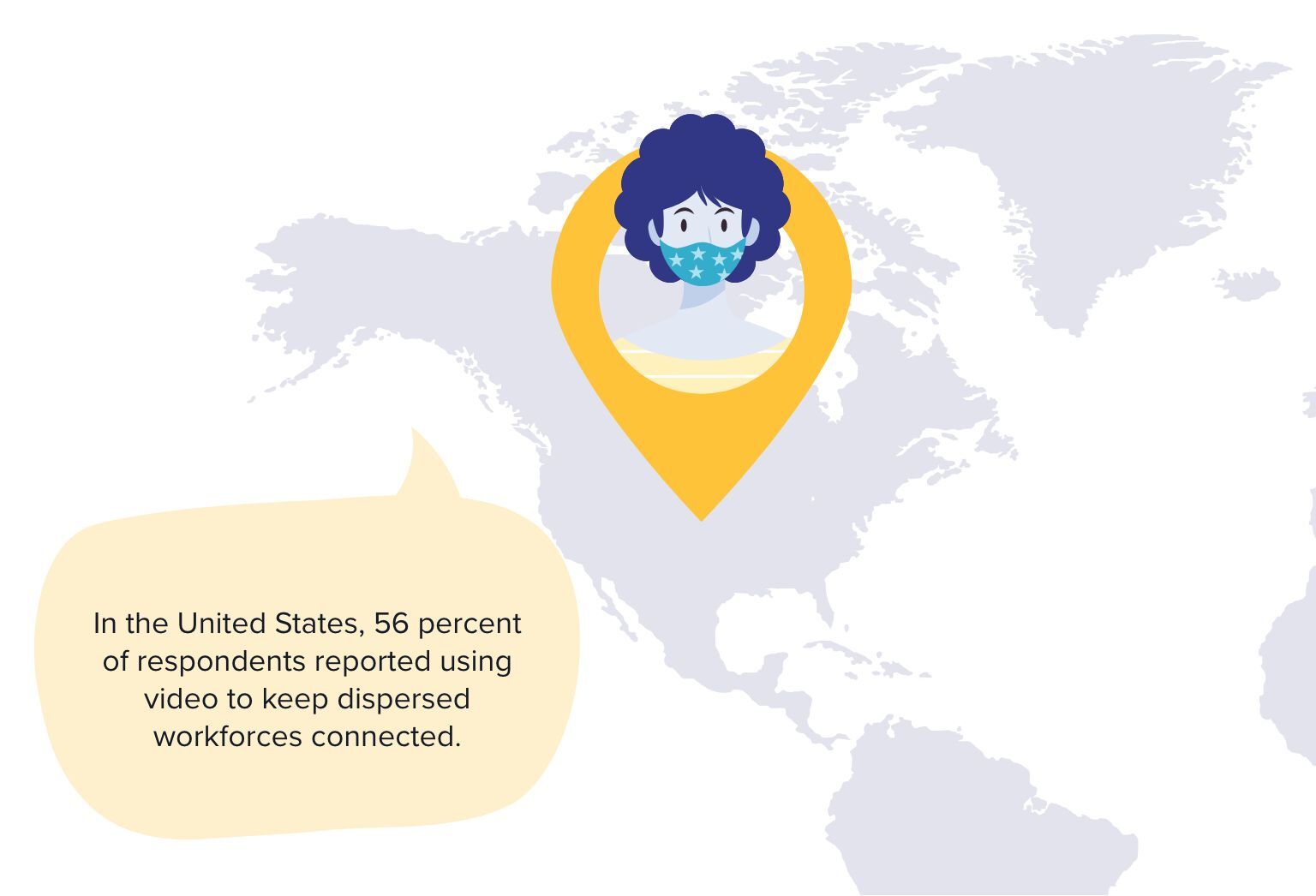
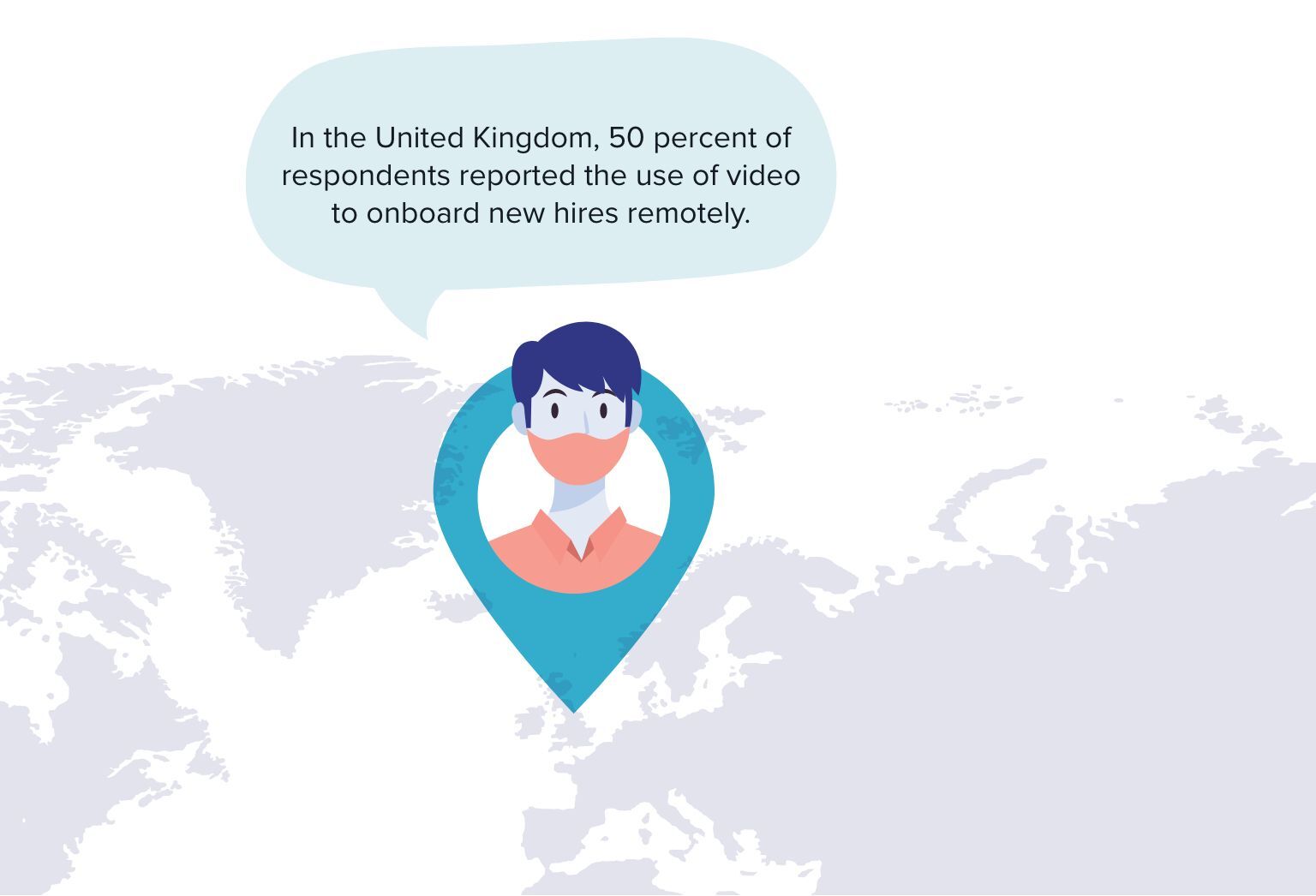

Why Video. Why Now?
Let's get down to business.
Attracting the best talent in a noisy environment and enhancing the candidate experience were – unsurprisingly - key priorities for survey respondents and a common use case for video powers.
Consistent business drivers across organizations big and small
These metrics remain largely the same across organization sizes.
Organizations with 100 – 1,000 employees consider video useful to better attract top talent (50 percent) and enhance the candidate experience (46 percent). These organizations also demonstrated a focus on improving diversity and inclusion and support related programs (42 percent).
For organizations with 1,000+ employees, 70 percent of respondents use video content to support talent acquisition or recruitment marketing activity. These organizations placed a greater emphasis on attracting top talent (66 percent) and enhancing the candidate experience (46 percent) with video.
North America leads with talent attraction, while APAC and UK drive candidate experience
While key business drivers remained steady across regions and organization sizes, respondents from North America reported a strong emphasis on using video to attract top talent (67 percent) and enhancing the candidate experience (56 percent).
Where these respondents differ most from other regions is the priority they’re placing on improving diversity and inclusion and support programs, with 50 percent of respondents in North America reporting this as a focus, versus Asia Pacific at 36 percent and Europe at 34 percent.
Respondents from Asia Pacific countries reported that the most popular business driver for the video was to enhance the candidate experience (56 percent). This is also the case in European countries (38 percent).
50%
are using video to enhance the candidate experience

50%
believe video is useful in attracting top talent in our industry or acquiring specific skills

40%
are using video to improve diversity and inclusion and support related programs

Whilst video is great for attraction - I had many candidates say the ONLY reason they applied for my jobs was because they got a sense of the culture via the video - getting broader support from outside of HR or TA will help to make the implementation more successful.
Strategy In Action
It's one thing to have a strategy. It's another to put it in action successfully. So where are different organizations putting their investments to video?
While business drivers for implementing video remained similar across organizations and regions, the video strategy changed as we flew from country to country.
A common theme in strategy for our emerging and current heroes was the use of video to communicate with candidates during the recruitment process. This was the most reported strategy across all organization sizes and regions in our survey, with respondents in North America stating that this was their most-used video strategy (51 percent).
Other popular strategies differed slightly across the world. Respondents from North America chose to amplify their job ads featuring a recruiter or hiring manager (41 percent) and focused on capturing employee stories for employer branding communications (39 percent).
This differed from countries in Asia Pacific, where respondents were more likely to use video to amplify the employee value proposition more effectively (33 percent).
Respondents from the United Kingdom and European countries reported using video to amplify job ads (32 percent) and the employee value proposition (26 percent).

Our Results
Respondents use video to:
45% - Communicate with candidates during the recruitment process
35% - Amplify job ads featuring a recruiter or hiring manager
27% - Capture employee stories for employer branding communications

Other popular strategies differed slightly across the world. Respondents from North America chose to amplify their job ads featuring a recruiter or hiring manager (41 percent) and focused on capturing employee stories for employer branding communications (39 percent).
This differed from countries in Asia Pacific, where respondents were more likely to use video to amplify the employee value proposition more effectively (33 percent).
Respondents from the United Kingdom and European countries reported using video to amplify job ads (32 percent) and the employee value proposition (26 percent).

My advice would be to start your video strategy with functions or people within your company that speak with customers or Partners often (Sales, Marketing, etc.). They most likely will be more willing to jump aboard videos and are often great advocates to speak highly of the company and culture.
Employee stories versus graduate programs
Almost nine in 10 survey respondents (88 percent) have experienced a moderate or significant benefit in social media engagement, while 90 percent also see a moderate or significant benefit in employer brand authenticity and awareness.
SOVT shows these benefits have resulted in delivering business impact across content engagement (26 percent), but importantly across candidate quality (25 percent) and time saved when hiring (19 percent).
In a reliable indicator of the efficacy of the three most popular strategies, 96 percent of respondents saw a moderate or significant benefit in candidate experience and engagement.
100 - 1,000 employees
Overall, respondents use video to:
47% - Communicate with candidates during the recruitment process
36% - Build an engaged talent pipeline for graduate programs
33% - Amplify job ads with videos that feature a recruiter or hiring manager

1,000+ employees
Overall, respondents use video to:
47% - Communicate with candidates during the recruitment process
43% - Capture employee stories for employer branding communications
33% - Amplify job ads with videos that feature a recruiter or hiring manager

1,000+ employees
- YouTube - 52%
- LinkedIn - 43%
- Facebook - 43%
- Company Career Site - 34%
- Instagram - 32%
- Email - 31%
- Job Boards - 24%
- Intranet Site - 20%
- TikTok - 14%
- Application Tracking System - 14%
- Vimeo - 13%
- Learning Management System - 11%
- Collaboration Tools (ie Slack) - 11%
1,000+ employees
- Employee stories - 42%
- Video job ads - 39%
- Recruitment process - 34%
- EVP - 31%
- Day in the Life - 29%
- General Communications - 25%
- Learning & Development - 24%
- Exec. Communications - 22%
- Professional Bio - 18%
- New Hire Offer - 18%

Video Maturity Model
We know that successfully leveraging video relies on consistency and experience, and progressing along the maturity curve of video adoption will drive stronger outcomes as more touchpoints in the candidate journey become optimized for engagement.
For the purposes of this report, we segmented video users into the following video adoption levels:
14% of respondents
Defining how they will use video in the candidate journey and solutions to support it
33% of respondents
Using video for one or two parts of the candidate journey to prove the concept
37% of respondents
Using video for several stages of the candidate journey and measuring results
16% of respondents
Deploying a video-led approach to candidate journey w/ supporting program management
The most advanced video adoption trends
The most advanced video adoption was found in North America and companies with 100 - 1,000 employees.
While key business drivers remained steady across regions and organization sizes, respondents from North America reported a strong emphasis on using video to attract top talent (67 percent) and enhancing the candidate experience (56 percent).
Where these respondents differ most from other regions is the priority they're placing on improving diversity and inclusion and support programs, with 50 percent of respondents in North America reporting this as a focus, versus Asia Pacific at 36 percent and Europe at 34 percent.
Respondents from Asia Pacific countries reported that the most popular business driver for the video was to enhance the candidate experience (56 percent). This is also the case in European countries (38 percent).
Interestingly, 22 percent of respondents from 100 - 1,000 employee organizations were advanced users, compared to just 9 percent of respondents from 1,000+ employee organizations.
Video Maturity 100 - 1,000 Employees
Respondents from these organizations were more likely to be intermediate users of video (33%) followed by beginners (26%).
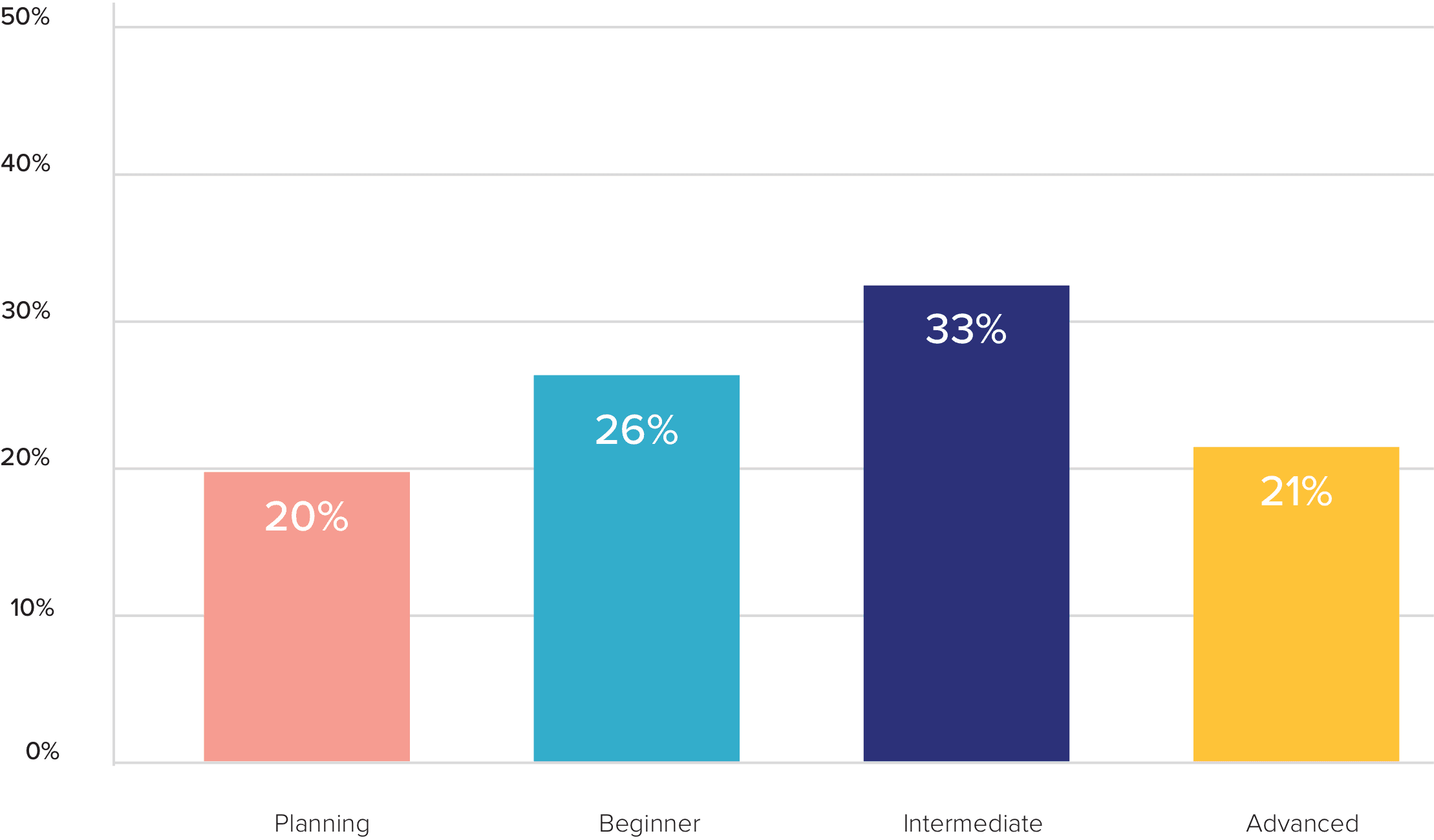
Video Maturity 1,000+ Employees
Respondents from these organizations were more likely to be beginner stages of video adoption (40%). Intermediate users followed at 34%.
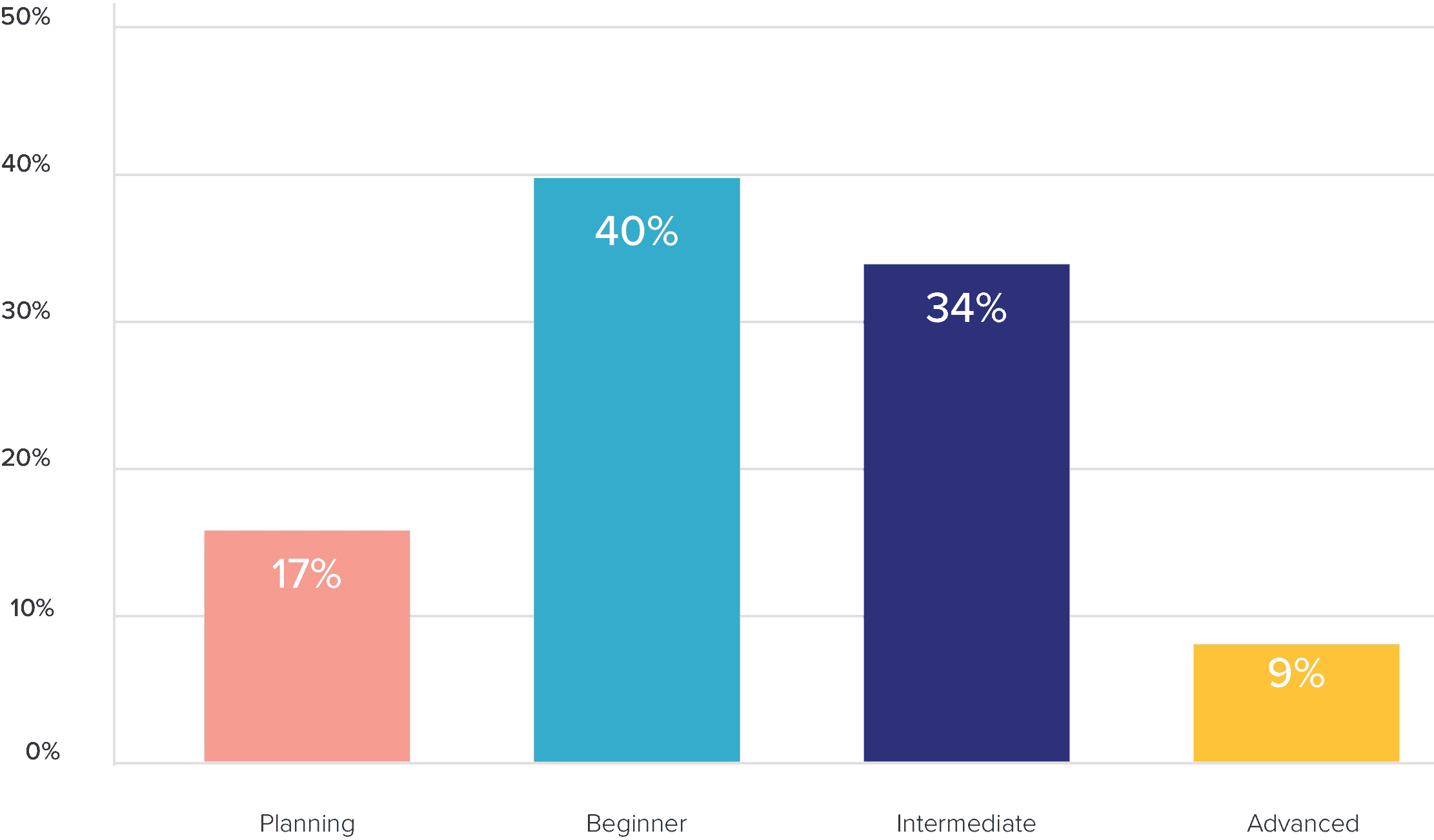
The seismic shift in video maturity over 12 months
Encouragingly, many of our respondents are now on the pathway to video hero status! In the past 12 months, 27 percent of those who now identify as video beginners weren't using video at all, 33 percent were planning to use video and 35 percent were beginners. In this year's study, 48 percent were intermediate users, 26 percent made the progression from beginner to intermediate, and just 15 percent were still planning to use video.
From those who now identify as advanced video users, before the pandemic, 54 percent already employed a video-led approach, 26 percent were intermediate, eight percent were beginners and 10 percent were planning.
Unique benefits are reported as video strategies mature
Across thee board, as our video-heroes progress from beginner through to advanced, the benefits diversify along with them. A unique benefit to those in the beginner stage of video is to raise the profile of recruiters or talent acquisition people in their organization. Intermediate users see the quality of candidates improve alongside their increased usage of visual content. Finally for the video-led organizations, unique benefits such as company careers page traffic, time spent on career site, and volume of applicants increase as their strategy matures.
Beginner
- 1 - Employer brand authenticity and awareness
- 2 - Social media engagement and reach
- 3 - Candidate experience and engagement
- 4 - Job Ad reach or views
- 5 - Raise the profile of recruiter to TA's
Intermediate
- 1 - Employer brand authenticity and awareness
- 2 - Candidate experience and engagement
- 3 - Social media engagement and reach
- 4 - Job Ad reach or views
- 5 - Quality of candidates
Advanced
- 1 - Candidate experience and engagement
- 2 - Employer brand authenticity and awareness
- 3 - Social media engagement and reach
- 4 - Company careers page traffic and time spent on site
- 5 - Volume applicants
Time and employee motivation biggest video challenges
Similar challenges appeared across the beginner and intermediate levels of adoption, with time and effort to create videos coming out on top as users learn to navigate a new content format. Advanced users found that motivating employees to create videos was their biggest challenge followed by video production costs. Interestingly as maturity progresses and organizations move towards video-led strategies, the challenge of measuring the impact and ROI decreases.
Beginner
- 1 - Time and effort to create videos
- 2 - Maintaining a consistent video quality
- 3 - How to measure impact and ROI
- 4 - Producing videos with remote teams
- 5 - Motivating employees to create videos
Intermediate
- 1 - Time and effort to create videos
- 2 - Motivating employees to create videos
- 3 - Maintaining a consistent video quality
- 4 - How to measure impact and ROI
- 5 - Producing videos with remote teams
Advanced
- 1 - Motivating employees to create videos
- 2 - Video production costs
- 3 - Maintaining a consistent video quality
- 4 - Time and effort to create videos
- 5 - How to measure impact and ROI
A Blueprint For ROI
So, who's getting the best results and how do they measure?
We know that video increases engagement, but those with a strong strategy and vision for video have a superpower, resulting in a meaningful impact and measurable ROI.
But creating impact is easier than you might think. Analyzing the patterns of our advanced users and those who return a strong ROI through video enables future video heroes to enhance their strategy.
Fifty-two percent of advanced users use employee stories, 50 percent use video job ads, while 62 percent of users who experienced a strong ROI use video job ads, and 51 percent use video in their recruitment process.
How to measure return on (video) investment
There are many ways to measure video ROI. From content engagement metrics, saving time and money in the recruitment process, candidate quality and experience to application volume and candidate diversity, ROI in the video is measurable across a range of areas, and is not limited to engagement.
Having a consistent video strategy is paramount to returning a strong video ROI.
The 28 percent of respondents who were unsure whether they experienced an ROI also had less aligned and focused strategies.
Of these respondents, just 31 percent are using video for candidate communications, 30 percent amplifying job advertisements, and 20 percent capturing employee stories.
Forty-three percent of these users also reported producing between 1 and 10 videos in the past 12 months – quality is key, but it will always be difficult to drive ROI with a low volume of video output.

Video ROI Strategies
Top video strategies for those reporting an ROI:
51% - Add videos to candidate communications for stages in the Recruitment Process
38% - Amplify Job Ads with videos that feature a recruiter or hiring manager
34% - Capture Employee Stories for Employer Branding communications
31% - Amplify the Employee Value Proposition in an authentic way
29% - Communicate the Team Value Proposition in employee words

Video isn't a magic wand with instant results, it's a slow burn, but one that sees candidates directly quoting our video content back to us at interviews, and sharing that video content is a key reason for their interest in Aurecon as an employer of choice.
Volume of videos strengthens ROI beyond content engagement
There is a correlation between those who report strong ROI on video and the number of videos produced. Two-thirds of respondents (66 percent) reporting a strong ROI say that they have produced between 10 - 100 videos in the past 12 months.
Of those who are unsure of whether their video activity has resulted in an ROI at this point, 43 percent of respondents say that they have produced between 1 and 10 videos in the past 12 months.
Of those who reported a strong ROI, the top three areas where respondents saw the most value were:
68%
Content engagement (reach, clicks, shares, views email open and click rate)
68%
Candidate quality (shortlist acceptance, interview to offer conversion, offer acceptance rate, quality of hire)
55%
Candidate Experience (Candidate/Employee satisfaction, Hiring Manager/Client satisfaction, Referral rate)
Weapons of mass (video) production
Your video doesn’t need to be directed by Spielberg and shot on SP BetaMax. Those who reported a strong ROI use an evenly distributed mix of smartphone-based and professional video production methods, ensuring their video is fit-for-platform.
Consistency of production plays a role in driving improved ROI – due to the producer’s ability to test and repeat over time.
Any videos result in better engagement
1 – 4 per month enhance the candidate experience
5+ per month generate better engagement, enhance the candidate experience and increase candidate quality and reduce time to fill roles.
51%
Both Smartphone Production and Professional Production
26%
Smartphone Production (employee-generated video)
23%
Professional Production (videographer or content agency)


The Benefits
For the advanced video users who say video has driven a positive ROI:
66% have seen improvements in content engagement
59% have seen improved candidate quality
57% have experienced cost reduction
The Journey Continues
Congratulations! You've now unlocked a new level of video superpowers! So, what's next?
Our survey has found that our respondents intend to continue the theme of 2021, as 73 percent of respondents plan to invest about the same or more in their video strategy over the next 12 months.
This year's key business drivers look set to continue:
Respondents have indicated the way they intend to achieve their talent goals is through employee stories (49 percent), video job advertisements (44 percent), and the production of "Day in the Life" videos (42 percent).
Using Video in the recruitment process is also a major part of the future plans of our respondents (37 percent) while improving the quality of videos is the primary focus (45 percent), followed by video engagement (31 percent).
No doubt in my mind that video will continue to accelerate in importance in terms of how it helps humanise talent strategies. [I hope] we see much higher levels of innovation in areas such as content production. It won't be enough to film the recruiter or hiring leader talking about a role, the material itself will need to inspire and move people to action.
Key Insights
- 53% - of respondents want to enhance the candidate experience
- 51% - of respondents want to better attract top talent in their industry or acquire specific skills
- 45% - want to increase the reach and awareness of their employer brand
Video Goals
- For the advanced video users who say video has driven a positive ROI:
- 45% - Quality of videos
- 31% - Engagement of videos
- 18% - Quantity of videos
- 6% - Nothing to improve, nailed it!
Attracting candidates is a totally changed game. Skills shortages will be with us for a long time. It's no longer primarily your job to 'assess' candidates. That's the easy part. Build trust, attract them, engage with them, and bring them to the hiring table. That is going to need a new suite of tools and skills, and authentic displays of culture, brand and ethos will be front and centre.
About VideoMyJob
We're VideoMyJob - the video creation platform used by video-heroes in the talent industry.
Since 2016, we've been helping companies make better connections with recruitment videos, employer brand videos, and employee engagement strategies.
Globally, video now accounts for more than 70 percent of all online traffic and is 12 times more likely to be shared online than text or pictures. The human preference for video is so strong that YouTube is predicted to overtake Google as the world's favourite search engine.
It's no surprise that talent professionals all over the world are turning to video to transform the way they communicate internally and externally to candidates and employees.
VideoMyJob was built to help talent teams quickly and easily create branded video content. Our vision is a world of greater human connection, with employee-created video at its core. Our technology simplifies the video creation process to alleviate the pain points of video production.
Actual videos made by talent professionals (like you) on the VideoMyJob platform from July 1, 2020 to June 30, 2021.
